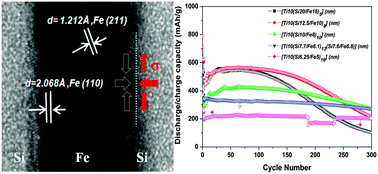Effect of multilayer structure on cyclic performance of Si/Fe anode electrode in Lithium-ion secondary batteries
Abstract
A

* Corresponding authors
a
Department of Materials Science & Engineering, Korea University, Seoul 136-713, Korea
E-mail:
kumetsrl@korea.ac.kr
Fax: +82 02 928 3584
Tel: +82 02 3290 3270
b Advanced Battery Research GroupCenter for Energy Convergence, Korea Institute of Science and Technology, Seoul 130-650, Korea
A

 Please wait while we load your content...
Something went wrong. Try again?
Please wait while we load your content...
Something went wrong. Try again?
H. Kang, S. Lee, W. I. Cho and B. Won Cho, Phys. Chem. Chem. Phys., 2013, 15, 1569 DOI: 10.1039/C2CP42824E
To request permission to reproduce material from this article, please go to the Copyright Clearance Center request page.
If you are an author contributing to an RSC publication, you do not need to request permission provided correct acknowledgement is given.
If you are the author of this article, you do not need to request permission to reproduce figures and diagrams provided correct acknowledgement is given. If you want to reproduce the whole article in a third-party publication (excluding your thesis/dissertation for which permission is not required) please go to the Copyright Clearance Center request page.
Read more about how to correctly acknowledge RSC content.
 Fetching data from CrossRef.
Fetching data from CrossRef.
This may take some time to load.
Loading related content
